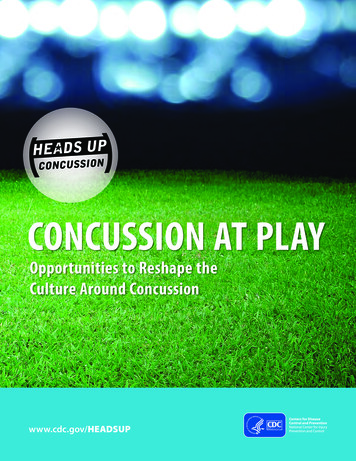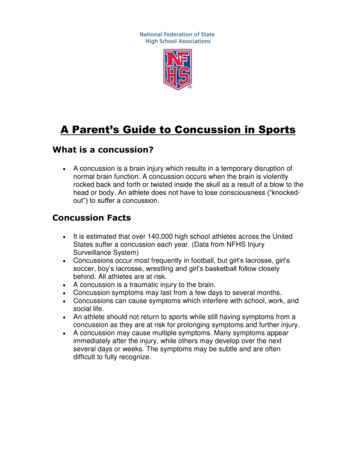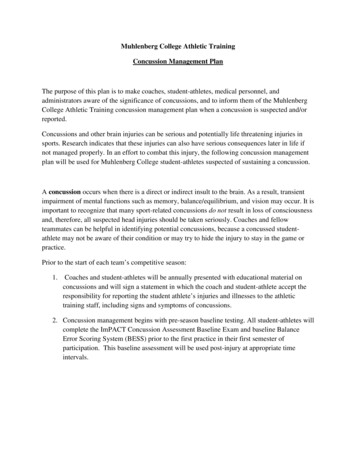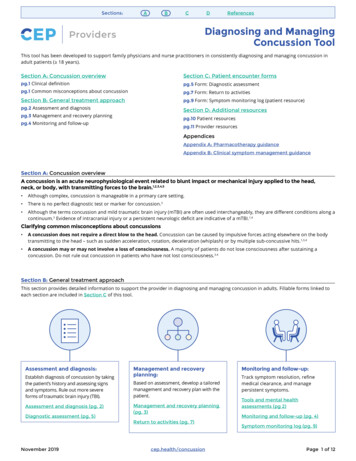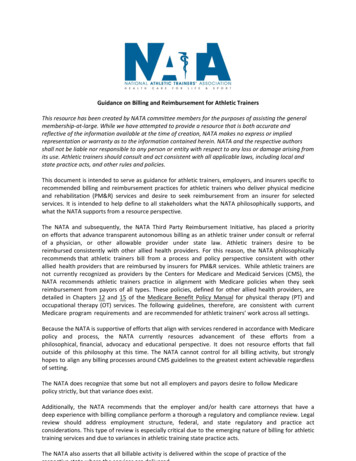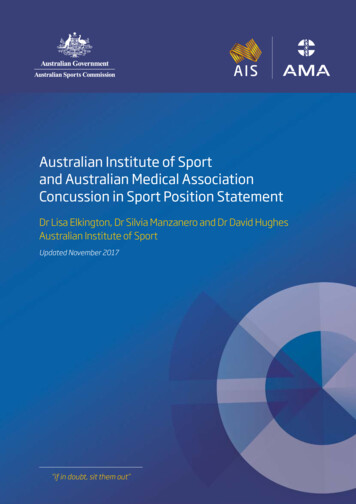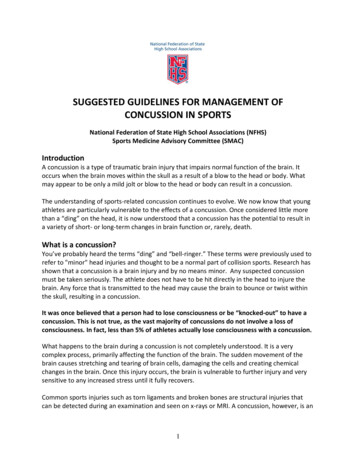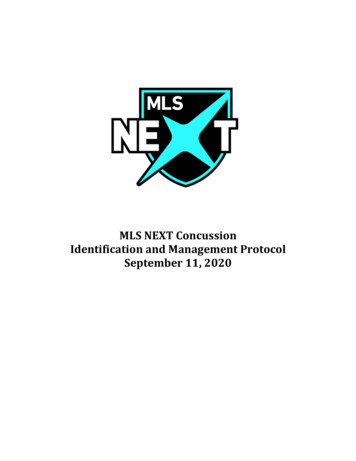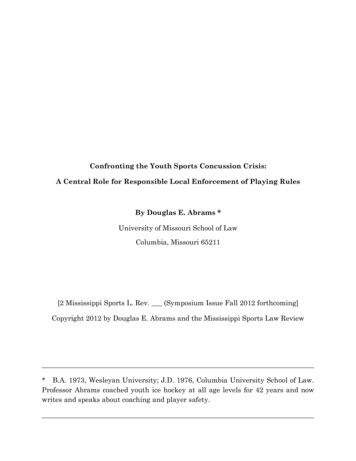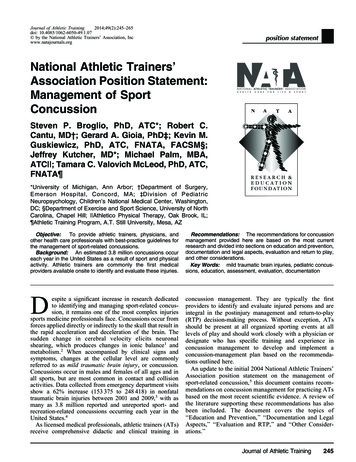
Transcription
Journal of Athletic Training2014;49(2):245–265doi: 10.4085/1062-6050-49.1.07Ó by the National Athletic Trainers’ Association, Incwww.natajournals.orgposition statementNational Athletic Trainers’Association Position Statement:Management of SportConcussionSteven P. Broglio, PhD, ATC*; Robert C.Cantu, MD†; Gerard A. Gioia, PhD‡; Kevin M.Guskiewicz, PhD, ATC, FNATA, FACSM§;Jeffrey Kutcher, MD*; Michael Palm, MBA,ATC ; Tamara C. Valovich McLeod, PhD, ATC,FNATA¶*University of Michigan, Ann Arbor; †Department of Surgery,Emerson Hospital, Concord, MA; ‡Division of PediatricNeuropsychology, Children’s National Medical Center, Washington,DC; §Department of Exercise and Sport Science, University of NorthCarolina, Chapel Hill; Athletico Physical Therapy, Oak Brook, IL;¶Athletic Training Program, A.T. Still University, Mesa, AZObjective:To provide athletic trainers, physicians, andother health care professionals with best-practice guidelines forthe management of sport-related concussions.Background: An estimated 3.8 million concussions occureach year in the United States as a result of sport and physicalactivity. Athletic trainers are commonly the first medicalproviders available onsite to identify and evaluate these injuries.Recommendations: The recommendations for concussionmanagement provided here are based on the most currentresearch and divided into sections on education and prevention,documentation and legal aspects, evaluation and return to play,and other considerations.Key Words: mild traumatic brain injuries, pediatric concussions, education, assessment, evaluation, documentationDconcussion management. They are typically the firstproviders to identify and evaluate injured persons and areintegral in the postinjury management and return-to-play(RTP) decision-making process. Without exception, ATsshould be present at all organized sporting events at alllevels of play and should work closely with a physician ordesignate who has specific training and experience inconcussion management to develop and implement aconcussion-management plan based on the recommendations outlined here.An update to the initial 2004 National Athletic Trainers’Association position statement on the management ofsport-related concussion,5 this document contains recommendations on concussion management for practicing ATsbased on the most recent scientific evidence. A review ofthe literature supporting these recommendations has alsobeen included. The document covers the topics of‘‘Education and Prevention,’’ ‘‘Documentation and LegalAspects,’’ ‘‘Evaluation and RTP,’’ and ‘‘Other Considerations.’’espite a significant increase in research dedicatedto identifying and managing sport-related concussion, it remains one of the most complex injuriessports medicine professionals face. Concussions occur fromforces applied directly or indirectly to the skull that result inthe rapid acceleration and deceleration of the brain. Thesudden change in cerebral velocity elicits neuronalshearing, which produces changes in ionic balance1 andmetabolism.2 When accompanied by clinical signs andsymptoms, changes at the cellular level are commonlyreferred to as mild traumatic brain injury, or concussion.Concussions occur in males and females of all ages and inall sports, but are most common in contact and collisionactivities. Data collected from emergency department visitsshow a 62% increase (153 375 to 248 418) in nonfataltraumatic brain injuries between 2001 and 2009,3 with asmany as 3.8 million reported and unreported sport- andrecreation-related concussions occurring each year in theUnited States.4As licensed medical professionals, athletic trainers (ATs)receive comprehensive didactic and clinical training inJournal of Athletic Training245
Table 1. Strength of Recommendation Taxonomy (SORT)aStrength ofRecommendationsARecommendation based on consistent and good quality experimental evidence (morbidity, mortality, exercise andcognitive performance, physiologic responses)Recommendation based on inconsistent or limited quality experimental evidenceRecommendation based on consensus; usual practice; opinion; disease-oriented evidenceb; case series or studies ofdiagnosis, treatment, prevention, or screening; or extrapolations from quasi-experimental researchBCabDefinitionReprinted with permission from ‘‘Strength of Recommendation Taxonomy (SORT): A Patient-Centered Approach to Grading Evidence inthe Medical Literature,’’ February 1, 2004, American Family Physician. Copyright Ó 2004 American Academy of Family Physicians. AllRights Reserved.Patient-oriented evidence measures outcomes that matter to patients: morbidity, mortality, symptoms improvement, cost reduction, andquality of life. Disease-oriented evidence measures are intermediate, physiologic, or surrogate end points that may or may not reflectimprovements in patient outcomes (eg, blood pressure, blood chemistry, physiologic function, pathologic findings).INJURY DEFINITIONTo best assemble the available concussion research andremain consistent with other medical groups, we sought toevaluate literature that defined concussion as a ‘‘traumainduced alteration in mental status that may or may notinvolve loss of consciousness.’’6 This definition wasselected based on its broad application by medicalorganizations and widespread use within the literaturefrom the time of the first National Athletic Trainers’Association position statement. We recognize the strengthof the definition provided by the International Concussionin Sport Group and its subpoints as valid features thatfurther define concussion.7 In evaluating and writing thisdocument, we also included research defining concussiveinjuries in these terms. Notably absent from the literatureand consistent with previous recommendations were theterms ‘‘ding,’’ ‘‘getting one’s bell rung,’’ ‘‘clearing thecobwebs,’’ and other such phrases in reference toconcussive injuries.5 These colloquial terms are antiquated, minimize injury severity, and should not be used torefer to concussion or mild traumatic brain injury.4. The AT should work to educate coaches, athletes, andparents about the limitations of protective equipment forconcussion prevention. Strength of Recommendation: C5. As part of educational efforts, ATs, athletes, coaches, andparents should read all warning labels associated withprotective equipment. Strength of Recommendation: CDocumentation and Legal Aspects6. The AT should be aware of any and all relevant governingbodies (eg, state, athletic conference) and their policiesand procedures regarding concussion management.Strength of Recommendation: C7. The AT should document the athlete’s (and whenappropriate, the parent’s) understanding of concussivesigns and symptoms and his or her responsibility to reporta concussion. Strength of Recommendation: C8. The AT should communicate the status of concussedathletes to the managing physician on a regular basis.Strength of Recommendation: C9. The AT should ensure proper documentation of theconcussion evaluation, management, treatment, return-to-RECOMMENDATIONS FOR CLINICAL PRACTICEEducation and PreventionThe clinical practice recommendations for each topichave been graded based on the Strength of Recommendation Taxonomy (SORT; Table 1).81. The AT should use, and educate others in using, theproper terminology of concussion and mild traumaticbrain injury as opposed to such colloquial terms as ‘‘ding’’and ‘‘bell ringer.’’9 Strength of Recommendation: B2. The AT should work with the appropriate administratorsto ensure that parents and coaches are educated on thefollowing aspects of concussion: prevention, mechanism,recognition and referral, appropriate return to participation, physical and cognitive restrictions for concussedathletes, and ramifications of improper concussionmanagement.10–12 Strength of Recommendation: B3. The AT should be aware of and document potentialmodifying factors that could delay the RTP, and patientsshould be educated on the implications of these conditionsas they affect recovery (Table 2).7 Strength of Recommendation: C246Volume 49 Number 2 April 2014Table 2. Factors That May Modify the Risk of Concussion andDuration of Recovery7RiskSymptomsModifiersNumberDuration (.10 d)SeveritySignsProlonged loss of consciousness (.1 min),amnesiaSequelaeConcussive convulsionsTemporalFrequency: repeated concussions over timeTime: injuries close together in timeRecency: recent concussion or traumatic braininjuryThresholdRepeated concussions occurring withprogressively less impact, force, or slowerrecovery after each successive eventAgeChild or adolescent (,18 y)Comorbidities and Migraine, depressions, or other mental healthpremorbiditiesdisorders; attention-deficit hyperactivity disorder;learning disabilities; sleep disordersMedicationPsychoactive drugs, anticoagulantsBehaviorDangerous style of playSportHigh-risk activity, contact or collision sport, highsporting level
participation progression, and physician communications.Strength of Recommendation: CEvaluation and RTP10. Athletes at high risk of concussion (eg, those in contact orcollision sports) should undergo baseline examinationsbefore the competitive season.5,13,14 Strength of Recommendation: B11. A new baseline examination should be completedannually for adolescent athletes, those with a recentconcussion, and, when feasible, all athletes.15–17 Strengthof Recommendation: B12. The baseline examination should consist of a clinicalhistory (including any symptoms), physical and neurologic evaluations, measures of motor control (eg,balance), and neurocognitive function.5,7,18–20 Strength ofRecommendation: B13. The baseline and postinjury examinations should beadministered in similar environments that maximize thepatient’s abilities, and all baseline examinations should bereviewed for suboptimal performance.21 Strength ofRecommendation: C14. Any athlete suspected of sustaining a concussion shouldbe immediately removed from participation and evaluatedby a physician or designate (eg, AT). Strength ofRecommendation: C15. The concussion diagnosis is made through the clinicalevaluation and supported by assessment tools.19 Strengthof Recommendation: B16. When the rapid assessment of concussion is necessary (eg,during competition), a brief concussion-evaluation tool(eg, Standardized Assessment of Concussion[SAC]20,22,23) should be used in conjunction with amotor-control evaluation and symptom assessment tosupport the physical and neurologic clinical evaluation.Strength of Recommendation: B17. Once a concussion diagnosis has been made, the patientshould undergo a daily focused examination to monitorthe course of recovery. Strength of Recommendation: C18. During the acute postconcussion recovery stage, dailytesting of neurocognitive function and motor control istypically not needed until the patient is asymptomatic.24Strength of Recommendation: C19. A concussed athlete should not be returned to athleticparticipation on the day of injury.9 Strength of Recommendation: C20. No concussed athlete should return to physical activitywithout being evaluated and cleared by a physician ordesignate (eg, AT) specifically trained and experienced inconcussion evaluation and management. Strength ofRecommendation: C21. Young athletes with a past medical history that includesmultiple concussions, a developmental disorder (eg,learning disabilities, attention-deficit hyperactivity disorder), or a psychiatric disorder (eg, anxiety, depression)may benefit from referral to a neuropsychologist toadminister and interpret neurocognitive assessments anddetermine readiness to return to scholastic and athleticactivities.7,25 Strength of Recommendation: C22. A physical-exertion progression should begin only afterthe concussed athlete demonstrates a normal clinicalexamination, the resolution of concussion-related symp-toms, and a return to preinjury scores on tests of motorcontrol and neurocognitive function.7,26 Strength ofRecommendation: C23. Concussed athletes who do not show a typical progressivereturn to normal functioning after injury may benefit fromother treatments or therapies. Strength of Recommendation: C24. Concussion-grading scales should not be used to managethe injury. Instead, each patient should be evaluated andtreated on an individual basis.7,9 Strength of Recommendation: B25. After the injury has resolved, the concussion may beretrospectively graded for the purpose of medical recorddocumentation. Strength of Recommendation: COther ConsiderationsEquipment.26. The AT should enforce the standard use of certifiedhelmets while educating athletes, coaches, and parentsthat although such helmets help to prevent catastrophichead injuries (eg, skull fractures), they do not significantly reduce the risk of concussions.7,27–29 Strength ofRecommendation: B27. Helmet use in high-velocity sports (eg, alpine sports,30–32cycling33–35) has been shown to protect against traumatichead and facial injury. Strength of Recommendation: A28. Consistent evidence to support the use of mouthguards forconcussion mitigation is not available. However, substantial evidence demonstrates that a properly fittedmouthguard reduces dental injuries.29 Strength of Recommendation: B29. Research on the effectiveness of headgear in soccerplayers to reduce concussion is limited. The use ofheadgear is neither encouraged nor discouraged at thistime. Strength of Recommendation: CPediatric Concussion.30. When working with children and adolescents, ATs shouldbe aware that recovery may take longer than in adults andrequire a more prolonged RTP progression.7,36,37 Strengthof Recommendation: B31. Age-appropriate, validated concussion-assessment toolsshould be used in younger populations.7,25 Strength ofRecommendation: C32. Assessment of postconcussion symptoms in pediatricpatients should include age-validated, standardized symptom scales and the formal input of a parent, teacher, orresponsible adult.38–40 Strength of Recommendation: B33. Pediatric athletes are undergoing continual brain andcognitive development and likely need more frequentupdates to baseline assessments.16,41 Strength of Recommendation: B34. Athletic trainers should work with school administratorsand teachers to include appropriate academic accommodations in the concussion-management plan. 7,39,42Strength of Recommendation: CHome Care.35. The AT and physician should agree on a standardconcussion home-instruction form (eg, Appendix A) thatis consistently used for all concussed patients, and a copyshould be maintained in the medical record. Both oral andwritten instructions for home care should be given to theJournal of Athletic Training247
36.37.38.39.40.41.42.concussed athlete and to a responsible adult (eg, parent orroommate) who will observe and supervise the patientduring the acute phase of the concussion.5,43 Strength ofRecommendation: CAfter a concussion diagnosis, the patient should beinstructed to avoid medications other than acetaminophen. All current medications should be reviewed by thephysician. 5,44,45 Strength of Recommendation: CAfter a concussion diagnosis, the patient should beinstructed to avoid ingesting alcohol, illicit drugs, orother substances that might interfere with cognitivefunction and neurologic recovery.5 Strength of Recommendation: CAfter the initial monitoring period, rest is currently thebest practice for concussion recovery. As such, there istypically no need to wake the patient during the nightunless instructed by a physician.5 Strength of Recommendation: CDuring the acute stage of injury, the patient should beinstructed to avoid any physical or mental exertion thatexacerbates symptoms.5,7,28,39,42 Strength of Recommendation: CIn addition to exclusion from physical activity related toteam activities, concussed student-athletes should beexcused from any activity requiring physical exertion(eg, physical education classes). Strength of Recommendation: CSchool administrators, counselors, and instructors shouldbe made aware of the patient’s injury with a recommendation for academic accommodation during the recoveryperiod.7,28,39,42 Strength of Recommendation: CA patient with a concussion should be instructed to eat awell-balanced diet that is nutritious in quality andquantity and should drink fluids to stay hydrated.5Strength of Recommendation: CMultiple Concussions.43. For an athlete with a concussion history, the AT shouldadopt a more conservative RTP strategy.7,46,47 Strength ofRecommendation: B44. Referral to a physician or designate with concussiontraining and experience should be considered when anathlete with a history of multiple concussions sustainsconcussions with lessening forces, demonstrates increasing severity with each injury, or demonstrates objective orsubjective changes in baseline brain function. Strength ofRecommendation: C45. The AT should recognize the potential for second-impactsyndrome in young patients who sustain a second traumato the brain prior to complete resolution of the firstinjury.1,48–50 Strength of Recommendation: C46. The AT should be aware of the potential for long-termconsequences of multiple subconcussive and concussiveimpacts.51–53 Strength of Recommendation: CSUPPORTING LITERATURE REVIEWEducation and PreventionWhen athletes, parents, coaches, administrators, andothers discuss concussive injuries, they should use theappropriate medical terminology: concussion or mildtraumatic brain injury. Use of such colloquial terms as248Volume 49 Number 2 April 2014‘‘ding,’’ ‘‘bell ringer,’’ and ‘‘getting your bell rung’’ has aconnotation that mitigates injury severity and should thusbe avoided. For example, a noted decline in neurocognitiveability at 36 hours after injury was reported in patientslabeled as ‘‘dinged’’ whose symptoms appeared to resolvewithin 15 minutes.9 This finding demonstrates a moreserious effect of what was initially considered a minorinjury.Before the competitive season, the AT should review allconcussion policies and procedures that outline injurydefinition, signs and symptoms, and the institution’s policyon concussion management (see ‘‘Documentation andLegal Aspects’’ below regarding how state laws andorganizational body regulations may influence institutionalconcussion policy). In many instances, the AT has access tothe most up-to-date information on concussion diagnosisand management. This information should be disseminatedto all of those involved in athlete health care as rapidly aspossible and in an appropriate manner. These individualsinclude but are not limited to coaches, athletes, parents,administrators, and other medical professionals. In additionto these documents, agencies have developed educationalinformation specific to coaches, athletes, and parents thathas been shown to effectively educate the target audience.54–56Athletes themselves have demonstrated limited knowledge regarding concussion symptoms; more than 50% ofhigh school athletes57 and 70% of collegiate athletes58 didnot report concussions sustained during football. Onereason for nonreporting was that athletes were not awareof the signs and symptoms of concussion. Another study59of high school rugby players demonstrated more knowledgeof concussion signs and symptoms (61%); however, theathletes had limited knowledge of postinjury concussionmanagement guidelines. For example, 25% of the athletesbelieved loss of consciousness was required for the injuryto be considered a concussion.59 Educational methods areeffective in increasing athletes’ awareness of concussionsymptoms. Goodman et al60 found that exposure to aconcussion-symptom video game improved symptomidentification among youth ice hockey players.60 Similarly,Bramley et al61 noted that high school soccer players whoreceived concussion education were more likely to reportconcussion symptoms to their coach.Researchers57 have documented athletes’ lack of willingness to report concussions to medical personnel, soparents of youth athletes should also be educated torecognize signs and symptoms of concussion. Parents (orguardians) typically have the most contact with youngathletes and so are well positioned to report atypicalbehavior, but many parents are not properly educated on thetopic of concussion.62 Sullivan et al63 reported that parentsof male high school rugby athletes were knowledgeableabout the signs and symptoms (83%) and the risksassociated with continuing to play while injured (96%),yet only half were aware of the appropriate RTP guidelinesafter injury.Even in the presence of an AT, coaches have theresponsibility for recognizing the signs and symptoms ofconcussion in athletes. Several studies, however, haveshown that coaches have limited knowledge and manymisconceptions related to concussions. In a survey of youthsports coaches, 45% of respondents believed a concussion
did not require immediate removal from a game or practice,and only 62% could correctly identify proper postconcussion management.10 In another investigation,64 high schoolcoaches demonstrated greater overall knowledge of sportconcussion (84%); they knew the most about injuryrecognition (92%) and the least about injury management(79%). Concussion-specific training is effective in improving injury knowledge: those attending a coaching educationprogram10 or a coaches’ workshop64 scored higher thannonattendees on their respective surveys. Sarmiento et al11reported that 34% of high school coaches using the Centersfor Disease Control and Prevention’s ‘‘Heads Up’’ tool kitfor concussion improved their concussion knowledge;specifically, they gained knowledge related to injury signsand symptoms. The coaches also noted that the tool kitchanged their attitudes and behaviors related to concussion.11 Similarly, a short (15–20 minute), interactive,online, concussion-education program aimed at youthsports coaches resulted in improvements in symptomknowledge, general knowledge, injury misconceptions,self-efficacy, and behavioral intention.12 Collectively, thesefindings suggest that a brief training session on sportconcussion signs, symptoms, and injury managementtargeted at coaching staff can improve injury recognition.This type of training may ultimately benefit the AT byencouraging coaches to help identify concussed athletesand follow treatment plans.After a concussive event, the AT should also educate thepatient and any additional stakeholders (eg, parents andadministrators) about the typical injury recovery. Althoughinjury severity and a precise time to recover cannot bepredicted immediately after injury, most concussed athletesreturn to their preinjury level of functioning within 2weeks.65 However, several factors, including specificsymptom patterns,7,66 age, and sex,67 may influence injuryrecovery and delay the return to participation (Table 2).Informing the patient about expected outcomes after injurymay reduce anxiety about the injury and associatedsymptoms.7,68Documentation and Legal AspectsCertified ATs, team physicians, and other health careproviders responsible for the management of patients withsport-related concussion should be aware of potentialliabilities involved with delivering medical coverage andmaking RTP decisions for patients. Concussion management has medical and legal implications, and the threat oflawsuits is increasing for sports medicine professionals.Previous lawsuits against ATs and team physicians haveaddressed the premature clearing of patients and, surprisingly, withholding patients from play after concussion.69–73Therefore, it is imperative for clinicians to manage theseinjuries in a systematic manner, using objective assessments, while documenting their daily findings. Certain legalprinciples are common to the laws of each state, butmaterial differences exist in the decisions of the highercourts for each state and in state statutes.74 It is, however,the responsibility of the AT to follow the best-practiceguidelines, recommendations, and practice limitationsadopted by their respective work setting or oversightorganization (eg, National Federation of State High SchoolAssociations, National Collegiate Athletic Association,National Football League) and the best practices forlicensed ATs established, in part, by the position statementsof the National Athletic Trainers’ Association. In addition,ATs working in states with concussion-managementlegislation are bound to follow those laws in the event ofa discrepancy with organizational guidelines or positionstatements.To avoid litigation, ATs should understand the generalelements of negligence and malpractice that typicallygovern claims for injury or death caused by impropertreatment. A tort is a private wrong or injury suffered by aperson as the result of another person’s conduct. The lawgives injured persons the right to be compensated throughthe recovery of damages. Torts may be intentional, meaningthat the person intended to act, or unintentional, in that theperson did not mentally intend to cause harm. A tort iscommitted when an AT fails to act as an ordinary andreasonably prudent person under similar circumstances andcauses injury to another person.74,75Negligence is an unintentional tort. Negligence law wasfounded on the principle that those who are harmed as theresult of others’ carelessness or failure to properly carry outresponsibilities must be compensated. The person who washarmed has the burden of proving that the 4 legal elementsof negligence are satisfied: a duty of care was owed as aresult of a relationship that existed between the parties; thedefendant breached the duty owed to the injured party; thebreach of the duty is proved to be the cause of the harm tothe plaintiff; and actual harm, not just the potential forharm, must have occurred. All 4 elements of negligencemust be proven in order for the plaintiff to be compensatedby the defendant for damages.75,76Athletic trainers employed to treat and manage athleticinjuries such as concussion owe a duty of reasonable care totheir patients and have been the target of lawsuits allegingfailures to meet the standard of care after sport-relatedinjury, especially concussion. Allegations against ATs incases of negligence after concussion most often includeimproper evaluation and testing of the patient, improperdocumentation, misunderstood communications with thepatient, and a lack of education of the patient or thepatient’s family.77 For ATs to minimize the risk ofbecoming defendants and to better defend themselvesshould a case be filed, they must understand the standard ofcare for managing specific injuries based on the most recentscientific literature. The standard of care in athletic trainingis defined as a person’s ‘‘legal duty to provide health careservices consistent with what other health care practitionersof the same training, education, and credentialing wouldprovide under the circumstances.’’78 Athletic trainers canlearn how the standard of care is applied to legal cases byexamining specific cases and the firsthand experiences ofthose who have defended ATs during the litigationprocess.77The athletic training profession must identify and adoptstandard practice limitations and guidelines to establish thestandard of care for managing concussions and other braininjuries. Ambiguity and the lack of a clear standard make iteasier for plaintiffs’ lawyers to construct theories ofliability for lawsuits against ATs, alleging they breachedthe standard of care after a suspected concussion.77Lawsuits against ATs often involve the evaluation ortesting of the patient (or lack thereof), documentation of anJournal of Athletic Training249
injury, communications with the patient or with a physicianabout a patient, and education of the patient.In a 2008 California case, an AT was found liable forfailing to properly and promptly evaluate a patient whoapparently had sustained a concussion only to later passout, fall, and suffer a variety of physical injuries as a resultof the AT’s alleged failures.79 The court ordered thedefendants to pay substantial damages to the injuredpatient. In another case, a University of Tennessee footballplayer recovered hundreds of thousands of dollars when anAT allegedly failed to promptly report a patient’s initial andongoing symptoms to a physician. The patient subsequentlysustained an acute subdural hematoma in connection withan injury incurred 1 month later.80 In another case, a highschool football player alleged that his AT failed to properlyevaluate him or take seriously his reported headaches anddizziness after a concussion and then prematurely returnedhim to play, which allegedly caused the patient to suffersecond-impact syndrome after a second concussion 2 weekslater.81 In this case, although the jury awarded no damagesto the injured player, the cost to the defendants was 3 yearsof litigation, substantial legal fees and expenses, and amonth-long, stressful, high-profile trial.Another possible allegation in the cases against ATsinvolves the lack of documentation in managing a sportrelated concussion. For several years, ATs have beenadvised to document ‘‘all pertinent information’’ surrounding concussions.5 The documentation of informationsurrounding the evaluation and management of anysuspected concussion should include but not be limited to(1) mechanism of injury; (2) initial signs and symptoms; (3)state of consciousness; (4) findings of the physical andneurologic examinations, symptoms, neurocognitive function, and motor control (noting any deficits compared withbaseline); (5) instructions given to the patient or parent (orboth); (6) recommendations provided by the physician; (7)graduated RTP progression, including dates and specificactivities; and (8) relevant information on the patient’shistory of prior concussion and associated recoverypattern(s). Though lengthy, this level of detail can helpprevent a premature return to participation, catastrophicbrain injury such as second-impact syndrome, and legalliability. The expression ‘‘if it’s not written, it didn’thappen’’ is often used i
Association position statement on the management of sport-related concussion,5 this document contains recom-mendations on concussion management for practicing ATs based on the most recent scientific evidence. A review of the literature supporting these recommendations has also been included. The document covers the topics of
